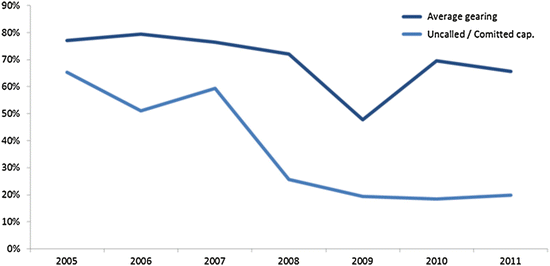Other Equity Markets for Shipping

Fig. 6.1
Total project capital invested in Norwegian market (balance is primarily senior debt, however in some cases supplemented by a sellers’ credit)
There is a definite advantage by using a specialist underwriter for a shipping KS/IS to secure a liquid second-hand market of the KS stakes. There are a few specialized underwriters of a shipping KS/IS of this type in Norway (see Fig. 6.2).


Fig. 6.2
Market shares of different Norwegian corporate finance service providers in shipping
6.2 Types of Structures
The most common Norwegian legal structures used as vehicles for private equity investments are:
Limited partnership (Kommandittselskap, “KS”)”
Silent partnership (Indre selskap, “IS”)
Limited liability company (Aksjeselskaper, “AS”)
General partnership (Anvarlig selskap, “ANS”)
The silent partnership has the most similarities with an offshore limited partnership and has become the predominant Norwegian legal structure. Both limited partnerships and silent partnerships are referred to as limited partnerships in this chapter which will not cover the AS structure.
6.2.1 Norwegian Limited Partnerships
The Norwegian limited partnership is governed by the Norwegian Partnership Act (“Selskapsloven”) of 23 June 1985 No. 83 (“Partnership Act”). The Partnership Act differentiates between various partnerships such as (a) general partnerships with unlimited liability for all partners (“ANS”), (b) internal partnerships with limited liability for the silent partners (“IS”), and (c) limited liability partnerships with limited liability for the limited partners (“KS”). Limited partnerships are governed not only by the provisions of the Partnership Act but also by the provisions of the limited partnership agreement (the latter only to the extent that there is no conflict with mandatory provisions of the Partnership Act).
6.2.2 The Limited Partnership “KS”
To be considered a single-purpose limited partnership (“KS”), the KS must be established by two or more individuals or legal entities, which may be Norwegian residents or foreigners, and must consist of one general partner (“komplementar”) and at least one or several partners with limited liability (“kommandittist”). The general partner must hold a minimum share of 10 % in the KS and has unlimited liability toward the company’s creditors to the extent of their personal assets. The limited partners make their contribution to the capital of the company and their obligations are limited to each partner’s share of the total committed capital of the KS. However, the limited partners hold a joint liability toward the KS if one of the other limited partners default on their obligations. A limited partnership does not require a minimum capital.
The primary company organ of the KS is the partnership meeting. The partners may choose not to elect a board of directors. In this case, the general partner will have powers and areas of responsibility similar to those of a board of directors. The general partner is always responsible for the supervision of the management of the day-to-day operations of the KS. Moreover, certain powers in principle belonging to the partnership meeting may be transferred to the general manager, depriving the partnership meeting of its right to instruct and set aside certain decisions made by the general partner.
It is required by the Partnership Act that the general partner provides at least 10 % of the committed capital of the KS and holds an interest in the KS similar to at least 10 % of its net assets and to share a part of at least 10 % of the deficits and profits of the KS. Each partner with limited liability must make a capital commitment of at least NOK 20,000 of which no less than 40 % must be paid within 2 years after its incorporation (the minimum amount of called and paid-in capital at the time of incorporation being 20 %). Provisions regarding payment of uncalled capital are left to be governed by the partnership agreement as the Partnership Act does not stipulate further requirements. It is usual that the partnership meeting or the general partner is given powers to demand payment of uncalled capital within a certain time limit. The KS’s claim against its partners for uncalled capital may not be transferred to any other party or assigned to any party by way of security (e.g. to a lender providing financing to the KS). Forty percent of the total committed capital shall be “locked-in” capital, meaning that only equity in excess of that amount may be distributed to the partners as long as the KS remains in existence (see Fig. 6.3).


Fig. 6.3
A specialty of Norwegian KS financing is the so-called uncalled capital
Even though a KS may be made subject to bankruptcy proceedings, the liability of the limited partners will always be limited to payment of their respective portion of the uncalled committed capital. Claims against such partners for payment of uncalled capital must be made by the KS itself (and/or its receiver) and may not be made directly by the KS’s creditors.